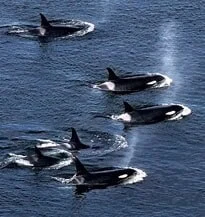The ocean is a deep and dark place. Haro Strait, our primary kayak tour route in the San Juan Islands reaches depths of over 400 meters. We sea kayakers enjoy the sunlit realm at the interface of air of water. But below 200 meters, there is no light and it becomes pitch-black and intensely cold. Even something as strong and fearsome as a killer whale could get unnerved while swimming through these inky depths. The senses of hearing and touch become the only means of tracking friends, foes, and prey.
Killer whales, perhaps better referred to by their old world moniker of orca, stick close together when they dive into this abyss. Orca whales stay within a few meters of each other during their deeper dives, often keeping their flippers in contact with each other. From our kayaks, we can see them do this at the surface during their sleep/rest periods when they are only partially conscious and must rely on body contact to avoid accidentally straying from the pod.

It surprises many of our kayak tour guests to learn that orca whales are classified in the dolphin family and share all the physical and social characteristics of their smaller cousins. They live in extended family groups called pods (what we would call clans), which can include over 100 individuals in some regions of the world. Pods that are closely related to each other form communities that frequently hunt, play, and travel together in larger groups that we call super-pods. Nested social structures of this kind are rare in nature and speak of the high degree of intelligence that orca whales possess.
We have 3 pods in our resident community In the San Juan Islands that number 82 whales currently. Historical evidence indicates that they once numbered close to 200 individuals before they were exploited by aquariums, persecuted by fisherman, and later subjected to dwindling prey and industrial toxins. Our local San Juan Islands population is considered genetically unique and has been listed under the Endangered Species Act as the twin problems of insufficient salmon (also endangered) and deadly toxins have not been alleviated.
Social animals such as orca whales and sea kayakers spend a great deal of time maintaining their relationships. Our San Juan Island orca whales have a culture that features matriarch leaders, large bulls that ritually compete for breeding dominance (quite a sight as some of this involves penis jousting), and multi-generational support and rearing of young. They really aren’t that different from us kayak tour guides!
In addition to the body rubbing, fin contact, and synchronized diving, there is a great deal of synchronized breathing. Matriarchs and their daughters and grand-daughters do this routinely, and the entire pod will synchronize breaths during sleep / rest. This is very similar to how we often naturally synchronize our paddles strokes on the kayak tours.
The salmon-eating orca whales in the San Juan Islands chatter to each other constantly when they aren’t sleeping. Sometimes we can hear their vocalizations right through the hulls of our kayaks when they get close. On the other hand, orca whales that hunt intelligent mammals such as porpoises and seals usually remain very quiet just like wolf packs that want to avoid alerting prey.
Each pod has unique calls that only they use, but the super-pods have a common language, much like the various tribes of the Coast Salish that used to live in the San Juan Islands. Orcas that live in different communities use completely different “languages” and it is not surprising that we see no interactions between orcas of different communities. In fact, within the waters of Washington state, we have three communities of killer whales that never socialize together salmon-eating “residents”, marine mammal-eating Bigg’s killer whales (now recognized as a unique species), and shark-eating “offshores”. Some of these communities have not interbred for over 100,000 years despite sharing the same waterways in the San Juan Islands.
Echo-location works like both sonar and ultrasound. One of the most unique aspects of killer whale vocalizations, like those of the entire “toothed whale” suborder, is their ability to create super high frequency sounds in their melon, the organ that gives their foreheads that rounded appearance. These are broadcast outwards and the echoes reflect back off bottom contours, kayaks, fish, other whales, etc., and are received via an oil-filled jawbone and conducted to the inner ear. Their brains have a special area that processes these sounds into a 3D holographic image of their surroundings. This ability enables them to navigate in the dark ocean, find prey, and identify foes. Their echolocation clicks penetrate into living bodies and produce “images” of skeletal structures and air pockets from lungs and swim bladders. Not only can they identify each species they encounter, they can also use it like ultrasound to peer into their pod-mates bodies. This means there are no secrets in the orca whales’ society, as everyone will know about pregnancies, injuries, tumors, and more. Think how our own society of kayakers would change if we could glance at anyone and know these private and intimate details about them!
